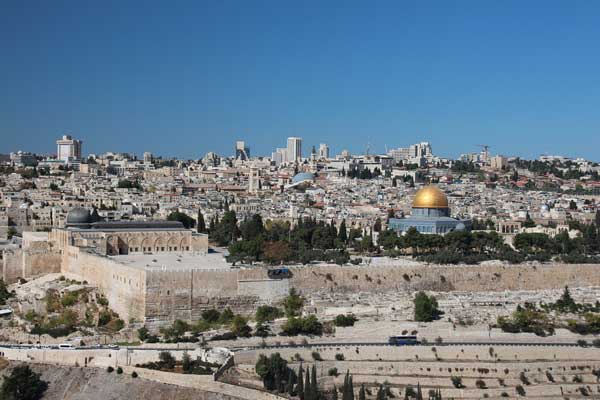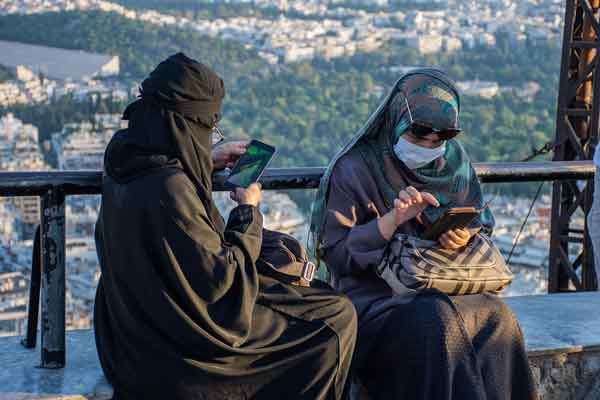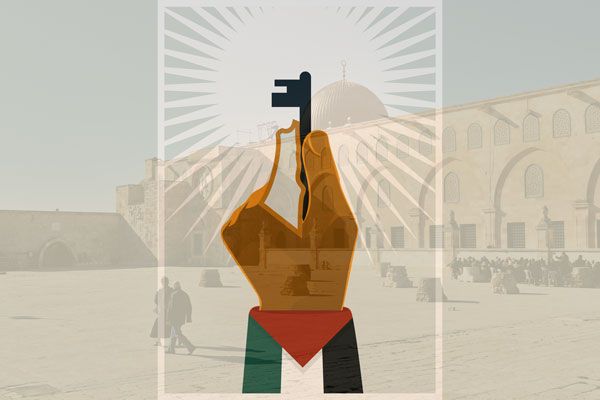Masjid Al-Aqsa in Jerusalem is important in Islam and beloved by Muslims for a number of reasons. First, it is important to note that the “holy” and “blessed” lands of Al-Aqsa are mentioned in numerous places in the Qur’an, such as Allah’s saying in Surat al-Isra: “Glory be to the One Who took His servant [Muḥammad] by night from Masjid al-Haram [the Sacred Mosque] to Masjid Al-Aqsa [the Farthest Mosque] whose surroundings We have blessed, so that We may show him some of Our signs. Indeed, He alone is the All-Hearing, All-Seeing” (17:1).
Masjid Al-Aqsa, as Muslims believe, was the mosque that Prophet Muhammad was transported to during the night journey (al-israa), and then to the heavens (al-mi’raj). It did not become blessed and holy only with the final messenger Muhammad (s) but rather it was always blessed and one of the first mosques on earth. It was authentically reported in a hadith that the great companion Abu Dharr (r) asked the Prophet (s), “O Messenger of Allah, which masjid was built first on earth?” The Prophet (s) replied, “The Sacred Masjid of Makkah.” Abu Dharr again asked, “Which was next?” The Prophet (s) said, “The Masjid al-Aqsa.” Abu Dharr (r) further asked, “How long was the period between the building of the two mosques?” The Prophet (s) said, “Forty years.” He added, “Wherever [you may be, and] the prayer time becomes due, perform the prayer there, for the best thing is to do so [i.e., to offer the prayers on time]” (Bukhari).
Based on a number of ahadith and reports from companions, some scholars opine that the first two mosques on earth, Masjid al-Haram and Masjid Al-Aqsa, were built by the forefather of humanity, aided by the angels, forty years apart. Generations later, it is believed that the two mosques were reconstructed by Prophet Ibrahim (Abraham) and his son, and then later Masjid Al-Aqsa was reconstructed by Prophet Dawud (David) and his son Suleiman (Solomon). This historical context is important in order to emphasize that Muslims believe that all prophets before Prophet Muhammad were also Muslims, and that the holy lands have always been holy and blessed lands.
The First Qiblah in Islam
Fast forward to the era of Prophet Muhammad (s) and one finds that the Muslims were directing all of their prayers towards Masjid Al-Aqsa. It is the first qiblah (direction one faces during prayer) in Islam. When Muslims migrated from Makkah to Madinah because of persecution and oppression, they faced towards Masjid Al-Aqsa for the first 17 months. It was during the second year after the hijrah (migration) that the revelation came down from the Creator about the change of prayer direction from Masjid Al-Aqsa in Jerusalem to Masjid Al-Haram, as found in Surat al-Baqarah (2:142-143). The masjid in Madīnah where Prophet Muhammad (s) was leading the Muslims in prayer is today called Masjid Qiblatayn, Masjid of the two qiblahs.
Fast forward once again to the reign of Umar b. al-Khaṭṭab (r), the great companion and righteous khaliph who extended Muslim-controlled territory and established justice in every part of it, and one finds that with the liberation of Jerusalem, it was once again a source of light and peace for the world. In the year 638 CE, the Christian Patriarch Sophronius insisted he would hand over the keys to Al-Aqsa only to Umar (r). After the peaceful surrender of Jerusalem, Umar (r) gave a speech that became known for centuries later as a treaty of religious pluralism and tolerance, particularly juxtaposed with the harshness of the previous Byzantine empire. Umar permitted Jews to enter Jerusalem, after they had been banned for over five centuries by the Christian Byzantine empire, and permission was given to Christians, Jews, and Muslims to visit and worship at Al-Aqsa, honoring religious diversity in the land. Umar’s Assurance, as it became known, influenced the Byzantine Empire in that it promoted greater tolerance and established the rights of minorities, and it was a proven exemplification of Islamic law in practice – that people of various religious beliefs could live in harmony side-by-side in one land.
The city of Jerusalem experienced several conquests, liberations, and occupations throughout the millennia after Umar (r). In 1187, for instance, it was freed from the Crusaders by Salahuddin Al-Ayyubi (also known as Saladin), and it continued to be a city that was open to various minorities to worship in peace under numerous Islamic dynasties throughout the ages.
No Longer a Land of Peace
Then we turn to the present century, and unfortunately the situation is no longer one of peace and good will. Since the 1917 Balfour Declaration and the 1948 colonial project to create the State of Israel, Palestine and the holy lands surrounding Al-Aqsa have been subjected to regular violence of various forms: structural (systemic), cultural (beliefs), or even physical attack by Israeli individuals or the State. The blessed land is now a land of occupation – in fact, the longest-lasting military occupation of our times – a land that demonstrates that settler colonialism and military control in the region matter more to some people than justice and rights. Religious freedom for Palestinians is limited, and in fact Muslims and Christians have both been harmed by the occupation in countless ways. Millions of Palestinians have been displaced throughout the past 73 years of occupation, hundreds of thousands displaced immediately in 1948 when Israel was formed as a nation-state, and Palestinian land has consistently been stolen as part of Israel’s greater project to completely wipe out Palestinian presence and identity. Ethnic cleansing is taking place today, and Palestinian lives – young and old – are being wiped out while the world watches.
What Israel has not accounted for, though, is the shifting tide in favor of human rights and justice. Due to the immediacy of communications technology and social media connectivity, people worldwide have been able to witness the violence and occupation as it occurs daily. Most of the world is horrified when bombs are dropped on residential buildings in Gaza, children are shot in the back, and families are evicted from their homes by force and replaced with Israeli settlers who say “If I don’t steal it, someone else will.” Yet, the greater concern is that of ongoing structural violence. The occupation itself with its checkpoints, open-air “prison,” and constant persecution and harassment of Palestinians of all ages and backgrounds is largely ignored by most of the world when the violence is not visual and immediate.
Accusations of Anti-Semitism Used to Silence Those Who Speak Out
The Israeli government is constantly working with powerful lobbying organizations, hundreds of millions of dollars in funding, and international political connections in order to spread its propaganda to every home, and the message is clear: criticism of Israel will be met with swift accusations of anti-Semitism. This obfuscating canard thrown at critics of Israeli policy has devastating effect on free speech and open discourse. It also brings harm to Jewish people in general as it raises the ire of people worldwide who recognize the oppression of Palestinians for what it is and know it is their right and duty to speak out. And, sadly, there will always be some number of individuals who will blame all Jews rather than those who are perpetrating the injustice. This, unfortunately, contributes to greater anti-Semitism.
In fact, baseless accusations of anti-Semitism by the Israeli government or by hardline Zionist persons and groups as a way to deflect criticism of the occupation and discriminatory policies has backfired in recent years, particularly with the recent evictions of residents of Sheikh Jarrah and the bombs dropped in Gaza. Much of the world is starting to realize the distinction between Zionism and Israel’s occupation on the one hand, and Judaism as a religion on the other, thanks to the many Jewish voices for peace in the world supporting Palestinian sovereignty and self-determination. When the occupation ends, one day soon God-willing, those who spoke the truth and stood up for justice will be seen as courageous and heroic, in contrast to those who remained silent and hid behind the “complexity of two sides” when clear injustice was occurring. Truly, silence in the face of injustice feeds injustice, and silence in the face of oppression invigorates it only more.
The Holy and Blessed Land
The land of Palestine will always be a holy and blessed land, even while it is occupied, but we believe a day will come soon in which occupation will be replaced with justice and freedom for all the people. The entire region of the Levant, in Islamic theology, plays a critical role at the end of times. The region is going to witness the emergence of Ad-Dajjal (the Anti-Christ), the presence of the Mahdi, the return of Prophet Jesus (Isa) from the heavens, and the prevention of Ad-Dajjal entering the three holy lands (Makkah, Madinah, and Al-Aqsa). Eventually, Ad-Dajjal will be slayed by Prophet Isa in the land of Al-Aqsa. It has also been reported in some narrations that the blessed land will also be the land of resurrection and gathering for the Day of Judgment.
We all want peace, or at least that’s what most people claim. However, justice is required in order to establish peace, because ongoing injustice and violence against a community is, by definition, an obstruction of peace. Peace is established upon rights, and the rights of Palestinians and the holy land are currently being violated, and as the tide continues to shift, slowly but surely, every voice and every facilitator of peace makes a difference.
We ask Allah to grant peace and justice to the region and to all communities worldwide.





